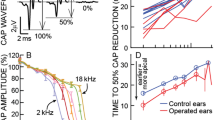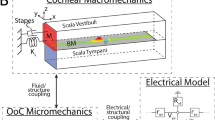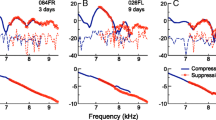Summary
Endolymphatic hydrops was induced in a series of adult pigmented guinea pigs. Distortion product otoacoustic emissions in general reflected the typical form of the hydropic compound action potential (CAP) audiogram, either with predominant low-frequency losses or a relatively flat audiogram. However, at certain two-tone combinations in some control ears the emissions could be smaller than expected from respective CAP audiograms, while in some hydropic ears the emissions could be larger than expected. The data presented here suggest that whilst the diagnostic value of distortion product emissions in the clinical situation might, at this time, be limited, the data from these emissions can give some insight into tonotopic hair cell function.
Similar content being viewed by others
References
Albers FWJ, Veldman JE, Huizing EH (1987) Early hair cell loss in experimental hydrops. Ann Otol Rhinol Laryngol 96:282–285
Aran JM, Rarey KE, Hawkins JE Jr (1984) Functional and morphological changes in experimental endolymphatic hydrops. Acta Otolaryngol (Stockh) 97:547–557
Bray P, Kemp D (1987) An advance cochlear echo suitable for infant screening. Br J Audiol 21:191–204
Brown AM (1987) Acoustic distortion from rodent ears: a comparison of responses from rats, guinea pigs and gerbils. Hear Res 31:25–37
Brown AM, Gaskill SA (1990) Measurements of acoustic distortion reveals underlying similarities between human and rodent mechanical responses. J Acoust Soc Am 88: 840–849
Brown AM, Kemp DT (1984) Suppressibility of the 2f2-f1 stimulated acoustic emissions in gerbil and man. Hear Res 13:29–37
Dallos P, Harris DM, Relkin E, Cheatham MA (1980) Two-tone suppression and intermodulation distortion in the cochlea: effect of outer hair cell lesion. In: Van Den Brink G, Bilsen FA (eds) Psychophysical, physiological and behavioral studies in hearing. University Press, Delft, pp 242–252
Gaskill SA, Brown AM (1990) The behavior of the acoustic distortion product 2f1-f2 from the human ear and its relation to auditory sensitivity. J Acoust Soc Am 88:821–839
Hall JL (1974) Two-tone distortion products in non-linear model of the basilar membrane. J Acoust Soc Am 56:1818–1828
Harris FP, Lonsbury-Martin BL, Stagner BB, Coats AC, Martin GK (1989) Acoustic distortion products in humans: systematic changes in amplitude as a function of f2/f1 ratio. J Acoust Soc Am 85:220–229
Henley CM, Owings MH, Stager BB, Martin GK, Lonsbury-Martin BL (1989) Post-natal development of 2f1-f2 otoacoustic emissions in pigmented rat. Hear Res 43:141–148
Horner KC, Cazals Y (1987) Rapidly fluctuating thresholds at the onset of experimentally induced hydrops in the guinea pig. Hear Res 26:319–325
Horner KC, Cazals Y (1989) Distortion products in early stage experimental hydrops in the guinea pig. Hear Res 43:71–80
Horner KC, Guilhaume A, Cazals Y (1988) Atrophy of middle and short stereocilia on the outer hair cells of guinea pig cochleas with experimental hydrops. Hear Res 32:41–48
Horner KC, Cazals Y, Guilhaume A (1989) Round window cochlear microphonics and atrophy of short and middle stereocilia on outer hair cells in hydropic cochleas in guinea pigs. In: Kemp D, Wilson JP (eds) Mechanics of hearing. Plenum Press, London, pp 207–215
Horner KC, Erre JP, Cazals Y (1989) Asymmetry of evoked rotatory nystagmus in the guinea pig after experimental induction of endolymphatic hydrops. Acta Otolaryngol (Stockh) [Suppl] 468:65–69
Kemp DT (1982) Cochlear echoes — implications for noise induced hearing loss. In: New perspectives in noise-induced hearing loss. Hamernik RP, Henderson D, Salvi R (eds) Raven Press, New York, pp 189–207
Kemp DT (1988) Developments in cochlear mechanics and techniques for non-invasive evaluation. Adv Audiol 5:27–45
Kemp DT, Bray P, Alexander L, Brown AM (1986) Acoustic emission cochleography. Practical aspects. Scand Audiol [Suppl] 25:71–95
Kemp DT, Ryan S, Bray P (1990) A guide to the effective use of otoacoustic emission. Ear Hear 11: 93–105
Kim DO (1986) Active and nonlinear cochlear biomechanics and the role of outer hair cell system in the mammalian auditory system. Hear Res 22:105–114
Kim DO, Molnar CE, Matthews JW (1980) Cochlear mechanics: nonlinear behavior in two-tone responses as reflected in cochlear nerve fiber responses and in ear-canal sound pressure. J Acoust Soc Am 67:1704–1721
Leonard G, Smurzynski J, Jung MD, Kim DO (1990) Evaluation of distortion product otoacoustic emissions as a basis for the objective clinical assessment of cochlear function. In: Cianfrone F, Cianfrone G, Kemp DT (eds) Cochlear mechanisms and otoacoustic emissions. Advances in audiology, vol 7. Karger, Basel, pp 139–148
Lonsbury-Martin BL, Martin GK (1990) The clinical utility of distortion-product otoacoustic emissions. Ear Hear 11:144–154
Lonsbury-Martin BL, Harris FP, Stagner BB, Hawkins MD, Martin GK (1990) Distortion product emissions in humans. Basic properties in normally hearing subjects. Ann Otolaryngol[Suppl] 236:14–28
Martin GK, Lonsbury-Martin BL, Probst R, Scheinin SA, Coats AC (1987) Acoustic distortion products in rabbit ear canal. Sites of origin revealed by suppression contours and pure-tone exposures. Hear Res 28:191–208
Martin GK, Probst R, Lonsbury-Martin BL (1990) Otoacoustic emissions in human ears: normative findings. Ear Hear 11:106–120
Probst R, Antonelli C, Pieren C (1990) Methods and preliminary results of measurements of distortion product otoacoustic emissions in normal and pathological ears. In: Grandori F, Cianfrone G, Kemp DT (eds) Cochlear mechanisms and otoacoustic emissions. Advances in audiology, vol 7. Karger, Basel, pp 117–125
Rydmarker S, Horner KC (1990) Morphological changes of hair cell stereocilia and tectorial membrane in guinea pigs with experimentally induced hydrops. Scanning Microsc 4:705–714
Schmiedt RA (1986) Acoustic distortion in the ear canal. Cubic difference tones: effects of acute noise injury. J Acoust Soc Am 79:1481–1490
Siegel JH, Kim DE, Molnar CE (1977) Cochlear distortion products: effects of altering the organ of Corti. J Acoust Soc Am 61: S2
Sziklai I, Horner KC, Ferrary E, Sterkers O, Amiel C (1989) Electrochemical composition of the cochlear fluids in early experimental hydrops. Acta Otolaryngol (Stockh) 107:371–374
Zurek PM, Clark WW, Kim DO (1982) The behavior of acoustic distortion products in the ear canals of chinchilla with normal or damaged ears. J Acoust Soc Am 72:774–780
Author information
Authors and Affiliations
Rights and permissions
About this article
Cite this article
Horner, K.C. Comparison of compound action potential audiograms with distortion product otoacoustic emissions in experimentally induced hydrops. Eur Arch Otorhinolaryngol 248, 302–307 (1991). https://doi.org/10.1007/BF00176760
Received:
Accepted:
Issue Date:
DOI: https://doi.org/10.1007/BF00176760




